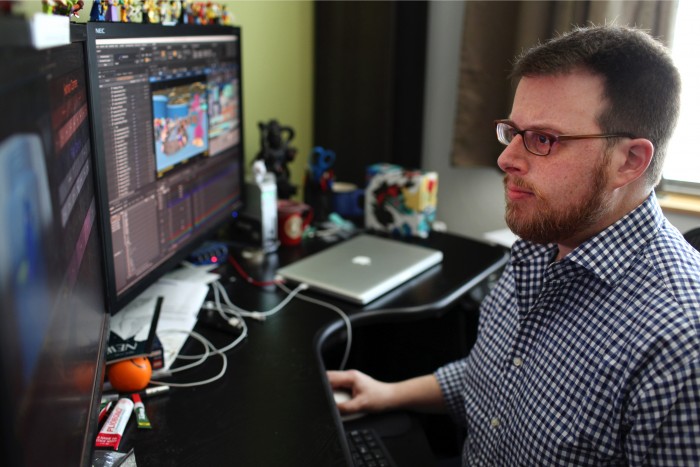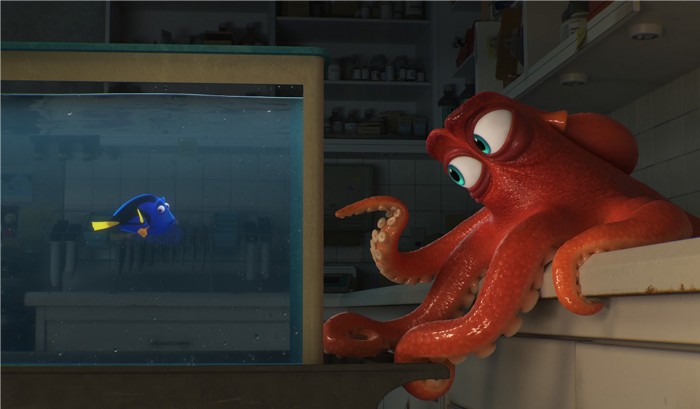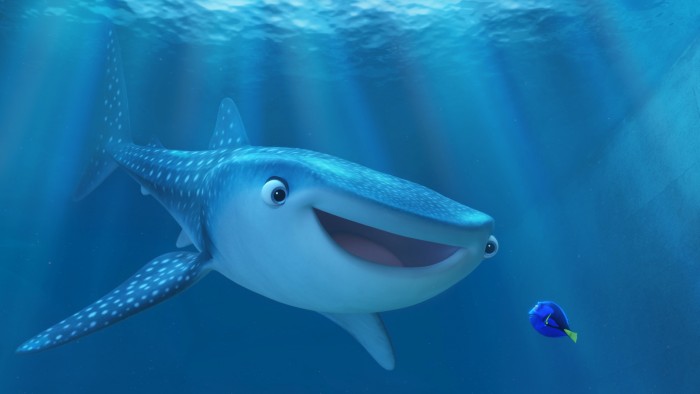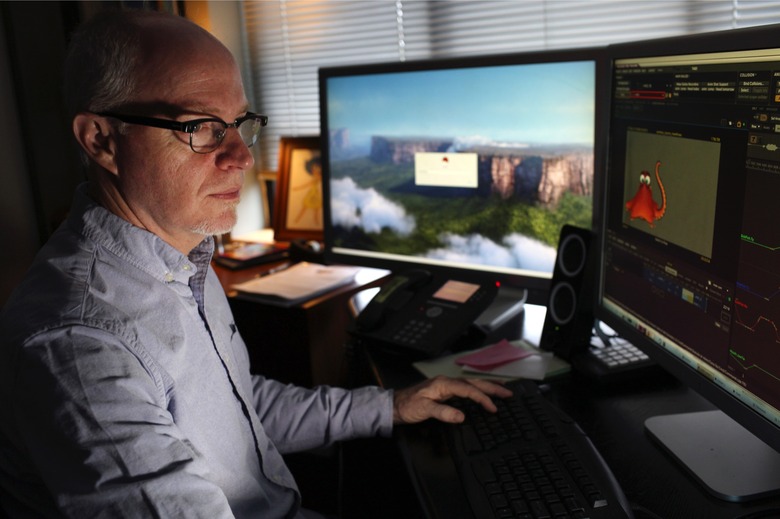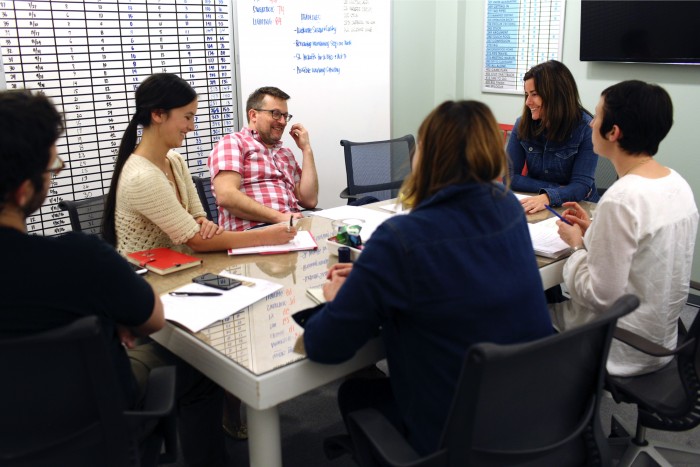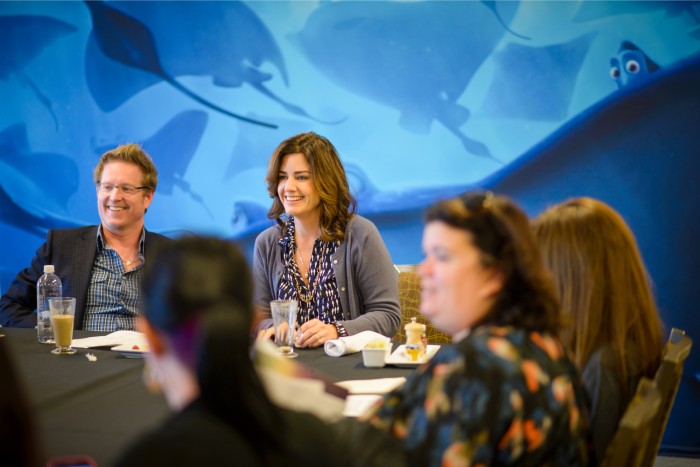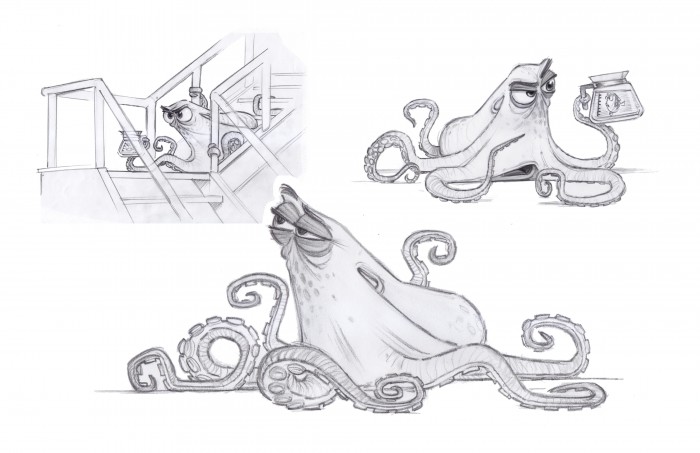How Unprecedented New Technology Made It Harder To Produce 'Finding Dory'
Each new Pixar film employs newer and better technology, but Finding Dory introduces an unprecedented amount of new software to their production pipeline. The company's chief technology officer Steve May, who worked on Finding Nemo as the supervisor of the shark sequence, says that the process of how they make films has changed a lot since then, but "mainly computers are way faster and algorithms are way better." Finding Dory introduces three completely new technologies and major improvements in one of their older pieces of software.
After the jump, you can learn about all the new technology being used in Pixar's latest feature film and how that allowed them to create a character that would have been impossible in the Finding Nemo days. Hear director Andrew Stanton explain how the advances change the filmmaking process, and his producer Lindsey Collins explains that while the new tools make things easier to create, it has made producing a Pixar movie even harder than it ever was before.
RenderMan RIS
While their animation software RenderMan has been around since the late 1980s (used in all of their films as well as many films that have won Oscars in the past 15 years), an entirely new version of the software was employed on Dory. There are basically two kinds of light: direct light and indirect light (which bounces off something else). In Finding Nemo, Pixar could only afford direct light and the lighting artists would create invisible light sources around the scene to mimic what indirect light might look like. That process is intensive as it's all created and designed by hand.
Finding Dory is the first Pixar film to use the RenderMan RIS architecture software, which is able to create both the direct and indirect light. This allows the lighting team to spend less time trying to mimic reality and more time making creative decisions. Finding Dory has a lot of water, and the software is also able to deal with reflected and refracted light in water, which impacts the color of the water. With something more complicated like a splash, the software is able to reflect and refract light on every single drop of water. Each shot in Finding Dory has billions of individual light rays per frame, with probably ten reflections and refractions in each ray.
On Finding Nemo, creating the look of water meant a lot of work by hand. Now all of that can be created automatically in the software. The software is also able to create foam, aeration inside the water, which adds another 100 reflections and refractions — all of which was not possible before this film. Fish tanks are very complicated, and in Finding Nemo Pixar had three or four people work for six months to add in the reflections on the tank and water surface. This was done by hand for every shot of the tank that you see in that film. In Finding Dory, it's all accomplished automatically.
Katana
One of the biggest challenges with lighting a computer-created scene is that it takes a lot of time to get feedback to see what a render will actually look like. Sometimes this takes minutes, but often times it takes hours for a single frame render. For Finding Dory, Pixar employed a Katana, a DCC app which creates more reactive renders and which works with RenderMan through a plugin. As they move a light source in a scene, the artist see a noisy-looking live render of the results which gradually improves in resolution. This means that the artists can see results without having to wait.
Universal Scene Description
USD is an efficient scalable system for authoring, reading and streaming time-samples. For Finding Dory, it allowed Pixar to to create more more complexity, like more detailed objects and scenes with thousands of moving fish. They created USD for their animated features but plan to provide it to other companies as open source software later this year.
Presto's Animation Recipes
Pixar's proprietary animation system Presto is not new: they've been using since Brave. But they've added new abilities to the software for this film. Sully in Monsters Inc. originally had tentacles, but Pixar was forced to get rid of them because they were too hard to animate. They have added a new ability to allow artists to simply draw tentacles rather than program tons of different points along each tentacle. The result is almost like bringing computer animation back to the hand-drawn days.
On Finding Nemo, they built blueprints to help them animate how each fish swims. On Finding Dory, they have created an animation recipe to help make the animation of the swimming more automatic, with controls to allow animators to change and alter how Dory swims. While it doesn't create the swim animation automatically, it helps take a lot of the tedious work out of it so animators can concentrate on the creative side of it.
On the next page director Andrew Stanton talks about how having these new tools changes the filmmaking process and producer Lindsey Collins explains how it's all made producing a Pixar movie harder.
Why New Improved Tech Makes Things Harder
As for all the new technology that Finding Dory has at its disposal, director Andrew Stanton says he appreciates it more because he fought so hard with the technology on the original Finding Nemo.
Like there's like one shot I think in Nemo where the camera goes around the bend of glass of a fish tank in the dentist's office and you kind of see a refraction happening on Nemo. We get that for free every shot now with this sophisticated software that we have. To the point that we had to like get rid of sometimes what a refraction really does 'cause it kind of starts to mirror and does weird stuff. And then going from the surface above water to cut through the water and then go below, we only did it once on Nemo, when the fishing net happens. That was so hard to do. We do it wherever we wanted to on this film. ... We could basically embrace the underwater like basically 100 percent now to what we would wanna see.
As for how the improving technology impacts storytelling, the idea that a challenge can inspire creativity, Stanton says he "weighs way too heavy on the other side" for that to be an issue.
I keep myself very dumb, probably to a halt, and I just go, I would love to see this. And this is why. And here's the deep, deep story reasons why it has to happen. So that I can force the technology into a corner and the other people to have to do it. And so I tend to be always pushing that way and that's where you get your Hank technology and the water technology advancements.
Finding Dory producer Lindsey Collins admits that the advancements in technology also means that "producing's gotten harder."
It's like literally because there are what used to be very clear limitations about what we could and couldn't do and how fast we could go. And well, we literally cannot render that shot, so we have to figure out a way to take out some of the backgrounds or shorten the scene or not have as many shots in the film that have that. ... The rendering is very cool, but it takes a long time for those 'cause it's not optimized. We've had 25 years to optimize our previous renderer and this one is like fresh out of the box. So we're discovering a lot on this film that I think subsequent films will benefit from. But it makes producing harder, because it makes it have to be kind of more about how do we wanna set up those limitations? And like where we wanna push. How do you wanna...? And it fundamentally always comes back to how do you wanna spend your money? Nobody's trying to save money. I know you're gonna spend it all. No question. We're gonna spend every dime we've got. So here's how much it's gonna cost. And that's a lot of the transparency that ends up helping. Because a lot of times when the director goes, oh wait, it's gonna cost six people weeks to do that one thing? Oh, forget it. Because everything is doable, it's just to what scale are you willing to kind of 'cause if you spend the six weeks here, that kind of means that six other shots that you're gonna wanna fix or do. Pixar's very good about being transparent with the directors, which I find to be really good. And it's kind of the only way that we in my mind get the highest percentage of our budget up on the screen. Because it's all about making sure that you're aware of where we're spending it.
Stanton adds, "Yeah, we don't wanna be an accidental roadblock to getting the film done."
On the last and final page we take a look at a character that couldn't have possibly have been created for Finding Nemo due to technology limitations. Find out how Hank the octopus was born.
The Creation of Hank the Octopus
When they were developing Finding Nemo, Stanton admits that the word octopus was something you couldn't even suggest on Finding Nemo as they just didn't have the technology to pull something like that off. The character of Hank the octopus was something that could never have been done with the technology used to create the original Finding Nemo. So even though Stanton may have considered an octopus character for the original film, that thought was quickly abandoned. But good ideas never stay buried and when they started developing Finding Dory, screenwriter Victoria Strouse was the one to suggest introducing an octopus character.
She came up with the idea of Hank mainly because she thought it would be fun to have a curmudgeon to be a foil against Dory, 'cause she needed somebody to bounce off of to be the Dory we know. And to also have somebody that had memory to be able to help track the progress of things. But also what was coming up 'cause she came here to Monterey at the same time as we did, in 2012, and we learned about the octopus, and how it's like an escape artist. She said, oh my gosh, it's the perfect physical vehicle to take a fish through places that fish just can't get around. It's the most ambulatory creature that there is from the ocean. And it's again, it's an escape artist. So the two married so well together that fortunately that came early 'cause we needed all the calendar time we could with that.
As for the other new creatures, and Stanton describes the process of selection as being "very visceral."
You just like looking at them. Like we did a research trip up to Vancouver and went to their aquarium and Beluga whales were not on my radar until I saw them and I couldn't stop watching them. It's the same thing that came up with Dory. I didn't know what a blue tang was. I didn't know what a clownfish was. I just opened up a my first book and there was these two fish poking out of an anemone. And I was like that's adorable. And I found out they're called clownfish. And I'm like, well done. And then I go, I need a complementary fish. I can pick any fish in the ocean. I went down to the Long Beach aquarium and they have right when you open through the main doors there's this large tank full of nothing but blue tangs and I couldn't stop looking at them. So it's like finding Lana Turner in a diner. It's just like, you just sit there and go, oh my gosh, the audience will watch that. Little did I even think that it's like it's the perfect complementary colors to orange and white, the blue and yellow. And so it's very visceral and sometimes and then sometimes it's the experience that I've had since then, because I've gone into the ocean and I've dove or I've watched, you know, I've been invited to a lot of things and suddenly discovered what whale sharks were and how fascinating. And I'm very aware of the marine life around here growing up. And me not being here for the last 25 years, sea lions and sea otters and they're fascinating. You can go on and on, right? There's several features worth of ideas in the ocean. Probably double digits. But you just kind of start there. And you just see what stays and goes. And that's no different than exploring an original idea. You just kind of overload the ingredients in the kitchen and you see what stays and what goes.
As for the four or five new main characters, Finding Dory producer Lindsey Collins says that "90 percent of those were kind of in the film early on."
Within the first year and a half we kind of had beluga and whale shark and otters and sea lions. So we had kind of a group of characters that we knew we liked. ... This is probably the most diverse film that the characters department had to deal with in terms of species. And they all move differently, swim differently, walk differently. They had to build all the different rigs. It was non trivial in terms of what we were asking them to do. They're like great, fish, we're like mm-hmm, an octopus and some birds. And they were like, oh fine.

